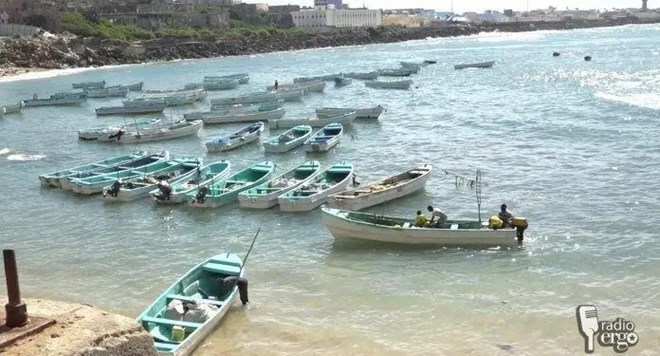
Awil Hassan Mohamed and his family of six have been facing food shortages since a storm that hit the coastal village of Idan, in central Somalia’s Mudug region on 14 March, destroyed his fishing equipment.
The storm also hit the coastal villages of Afweyn, Lafa’ade and Galhagoog, putting many fishermen out of work.
Awil lost a boat and engine and four fishing nets in the storm. In addition, the strong winds washed up an unusual number of dead fish onto the shore. Even though he has been going out to see in his remaining boat, he has not been able to make a catch worth selling.
“We have lost the lobsters that we used to get from the sea and sell. I used to get between $7 and $10 a day. That is how I used to manage my life. Now we cook only once a day,” he complained.
The lack of fish forced Awil to turn to casual work breaking rocks for construction although he only gets called up once in 10 days and earns $3 or $4 per job.
He is taking loans from local stores to feed his family and sometimes getting food from his relatives.
There is also a water shortage in Idan village as the wells dried up in the long drought and locals now buy a barrel of water at $4.
Awil’s family are rationing themselves to half a barrel of water a week and he has yet to pay $12 for the water they have used since March.
In his 20 years as a fisherman, Awil says he has only seen such mass destruction of fish and sea creatures in the ocean once before, following the Tsunami that hit Somalia’s coast.
“An occurrence like that happened in the sea once in 2004. It hasn’t happened after that time until now. The pollution and the rise of the ocean water both happened. A few people have gone back to fishing now and they aren’t earning anything from it,” he complained.
He is considering migrating from his village and moving to Galkayo, 280 kilometres away, so that he can earn a better income.
Mohamed Abdikarin Hassan, a fisherman living in Afweyn is one of the few fishermen still going out on fishing trips.
He and his team travel about 500 miles out to sea once a week beyond the polluted areas to fish in the deep ocean but sometimes get very little or no catch. Since this month’s storm, they have been counting losses. They use fuel worth $300 on each expedition and do not make enough income to cover the costs.
The trips are also fraught with many risks. Mohamed witnessed four fishermen who drowned at sea this month.
“Sometimes when the fishing nets are cast and people don’t see because of the unclear water they get caught up and suffocated,” he said.
“We also catch dead lobsters, and the fishing nets sometimes get stuck in waste and are hard to pull them out. The boat engines too sometimes break down.”
He was doing well on $80-$90 a day, paying $40 to his workers and using the rest to take care of his wife and four children. Currently, however, his family is relying on food loans from local traders. He hopes he will be able to repay when fishing picks up again.
A lecturer in environmental studies at Himilo University in Mogadishu, Sakari Omar Macalin Abdulle, told Radio Ergo that several storms have hit Somalia’s coastal areas in the last year raising the alarming trend of many dead fish being washed up on the shore.
“There are some factors that could cause this phenomenon although there has not been any thorough research. It could be because of reduced oxygen in the sea. As we know, Somalia has not received good rains in the last five years and the sea is one of the areas that need rain, because the rain provides oxygen. There are also chemicals dumped in the sea, which affect marine life. There could also be outbreaks of diseases affecting the fish,” he observed.
The coastal areas of Mudug region have seen reduced rainfall in the past three years. Many pastoralists who have lost their livestock have been turning to fishing although they are now faced with new challenges in the ocean.











